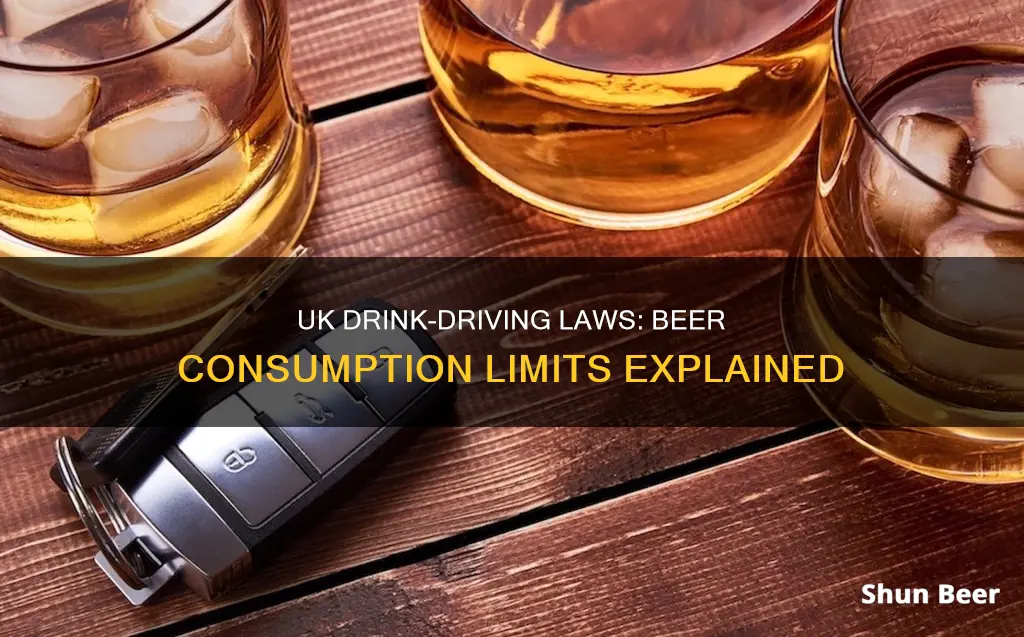
Drinking and driving is a criminal offence in the UK, and it's impossible to say exactly how many drinks are safe as it differs from person to person. The safest advice is to not drink and drive at all. However, if you're in England, Wales or Northern Ireland, the drink-drive limit is 80 milligrams of alcohol per 100 millilitres of blood or 35 micrograms of alcohol per 100 millilitres of breath. In Scotland, the limit is lower, at 50 milligrams of alcohol per 100 millilitres of blood and 22 micrograms of alcohol per 100 millilitres of breath.
| Characteristics | Values |
|---|---|
| Drink-drive limit in England, Wales and Northern Ireland | 80 milligrams of alcohol per 100 millilitres of blood or 35 micrograms of alcohol per 100 millilitres of breath |
| Drink-drive limit in Scotland | 50 milligrams of alcohol per 100 millilitres of blood or 22 micrograms of alcohol per 100 millilitres of breath |
| Number of units men can drink in England, Wales and Northern Ireland | 4 units |
| Number of units women can drink in England, Wales and Northern Ireland | 3 units |
| Number of pints of medium-strength lager or cider (4.5%) men can have in England, Wales and Northern Ireland | 2 pints |
| Number of pints of medium-strength lager or cider (4.5%) women can have in England, Wales and Northern Ireland | 1 pint |
| Number of standard glasses of wine (13%) men can have in England, Wales and Northern Ireland | 2 glasses |
| Number of standard glasses of wine (13%) women can have in England, Wales and Northern Ireland | 1 glass |
| Number of single shots (35ml) of spirits (40%) men can have in England, Wales and Northern Ireland | 4 shots |
| Number of single shots (35ml) of spirits (40%) women can have in England, Wales and Northern Ireland | 3 shots |
What You'll Learn

How much beer can I drink and still drive in England, Wales and Northern Ireland?
The amount of beer you can drink and still drive depends on several factors, including your weight, age, sex, metabolism, and the amount of food you've eaten. It's important to note that drinking any amount of alcohol can impair your judgement and increase the risk of accidents, so the safest option is to avoid drinking entirely if you plan to drive.
With that said, in England, Wales, and Northern Ireland, the legal alcohol limit for driving is typically around 80 milligrams of alcohol per 100 millilitres of blood or 35 micrograms of alcohol per 100 millilitres of breath. This roughly translates to around three units of alcohol for women and four units for men.
To give you a better idea, here are some examples of how much beer a person can drink and still be under the drink-drive limit:
- A man can have two pints of medium-strength lager or cider (4.5%) and be under the limit.
- A woman can have one pint of medium-strength lager or cider (4.5%) and be under the limit.
- A man can have two standard glasses of wine (175ml, 13% ABV) and be under the limit.
- A woman can have one standard glass of wine (175ml, 13% ABV) and be under the limit.
It's important to remember that these are just estimates, and the actual number of drinks that can be consumed before reaching the legal limit will vary from person to person. Additionally, alcohol can stay in your system for up to 24 hours, so even if you wait several hours after drinking, you may still be over the limit.
The effects of alcohol can vary, and it's challenging to determine your personal drink-driving limit accurately. Therefore, it's always best to avoid drinking if you plan to drive or wait for a substantial amount of time before getting behind the wheel.
Old Beer: Poisonous or Perfectly Safe to Drink?
You may want to see also

How much beer can I drink and still drive in Scotland?
If you are driving in Scotland, the advice is clear: do not drink any alcohol. Scotland has a zero-tolerance approach to drinking and driving. The limit is not about how much you can drink, but how much alcohol is in your body, which can be detected in your breath, blood or urine.
The drink-drive limit in Scotland is:
- 22 micrograms of alcohol per 100 millilitres of breath
- 50 milligrams of alcohol per 100 millilitres of blood
- 67 milligrams of alcohol per 100 millilitres of urine
These limits are lower than in the rest of the UK.
It is impossible to say how many drinks this equates to, as it is different for each person. Many factors influence how alcohol is absorbed by the body, including weight, age, sex, metabolism, medication, tiredness, dehydration, and whether food has been consumed.
The safest advice is to avoid alcohol altogether if you plan to drive. If you need to drive, consider being the designated driver and opting for low or non-alcoholic drinks.
Beer and No-Carb Diets: What You Need to Know
You may want to see also

How long after drinking beer am I safe to drive?
The amount of time it takes for alcohol to leave your system depends on several factors, including weight, age, sex, metabolism, diet, and stress levels. The general rule is that it takes about one hour for your body to process one unit of alcohol. However, this can vary depending on the individual and other factors such as the amount and type of alcohol consumed.
To be safe, it is recommended to wait at least 12 to 24 hours after drinking before driving, especially if you have consumed a large amount of alcohol. This is because alcohol can stay in your blood for up to 6 hours and on your breath for up to 24 hours after your last drink. Even if you feel fine, your blood alcohol concentration could still be over the legal limit, which is 80 milligrams of alcohol per 100 millilitres of blood or 35 micrograms of alcohol per 100 millilitres of breath in England, Wales, and Northern Ireland. In Scotland, the limit is stricter, with 50 milligrams of alcohol per 100 millilitres of blood and 22 micrograms of alcohol per 100 millilitres of breath.
To give you an idea, a man who weighs 85 kg and drinks 3 pints of 4% strength lager at 11 pm would be over the UK drink-drive limit. It would take roughly 8 hours for the alcohol to leave his system, so he might be okay to drive by 7 am the following morning. However, drinking an extra pint would mean he would need to wait until at least 9:30 am. If he were to be pulled over by the police on his way to work, he could still be over the drink-drive limit.
It is important to note that there is no definitive way to know how long it will take for the alcohol to leave your system, and the safest option is to avoid drinking and driving altogether. If you plan on drinking, it is best to arrange alternative transportation, such as a designated driver, public transport, or a taxi.
Beer and Methotrexate: What's Safe to Drink?
You may want to see also

What happens if I'm caught drinking and driving?
Drink driving is a criminal offence in the UK, and if caught, you could face serious penalties. The police have the right to ask anyone who is driving, attempting to drive, or in charge of a vehicle and who they suspect has been drinking, to take a breath test. If you refuse to take the test without a reasonable excuse, you will be arrested. If you fail the breath test, you will be taken to a police station for a second test. Failing either test without a reasonable excuse is considered an offence.
If you are found to be over the legal alcohol limit, you will be charged with drink driving. The penalties for drink driving include an unlimited fine, a driving ban, and up to six months' imprisonment. The sentence depends on the severity of the offence and is decided by a magistrates' court. If you are convicted twice in ten years, the penalties can be even more severe.
In addition to criminal penalties, a drink-driving conviction can also have other consequences. Your car insurance costs will increase significantly, and if you drive for work, your employer will see the conviction on your licence. It may also make travel to certain countries, such as the USA, more difficult.
The safest approach is to avoid drinking and driving altogether. If you plan to drink, consider alternative transportation options such as public transport, a designated driver, or a licensed taxi service.
Beer and Metro North: What's Allowed?
You may want to see also

How can I stay safe if I do drink and drive?
Drinking and driving is extremely dangerous and can lead to serious injuries, fatalities, and legal consequences. The safest approach is to avoid drinking alcohol altogether if you plan to drive. The effects of alcohol vary from person to person, and even a small amount of alcohol can impair your driving ability.
However, if you do choose to drink and drive, here are some ways to stay as safe as possible:
- Use a breathalyser: Before getting behind the wheel, use a personal breathalyser to check your blood alcohol concentration (BAC). While these devices may not be 100% accurate, they can give you an indication of your alcohol level. Always err on the side of caution.
- Understand your alcohol tolerance: Everyone processes alcohol differently. Factors such as weight, age, sex, metabolism, and food consumption influence how quickly your body metabolises alcohol. Know your personal limits and don't rely solely on how you feel.
- Wait it out: On average, the body can process about one unit of alcohol per hour. However, this rate varies depending on individual factors. If you've been drinking, it's always safer to wait longer than you think before driving.
- Stay hydrated: Drinking water along with alcoholic beverages can help reduce your overall blood alcohol concentration.
- Plan ahead: If you know you'll be consuming alcohol, arrange alternative transportation in advance. This could include a designated driver, a taxi, a ridesharing service, or public transport.
- Avoid myths: Drinking coffee, taking cold showers, or eating will not speed up the rate at which your body metabolises alcohol. These might make you feel more alert, but they won't reduce your BAC.
- Stay informed: Keep yourself updated about the drink-driving limits in your area. Remember that even small amounts of alcohol can affect your driving ability and increase the risk of accidents.
- Wear your seatbelt: Always wear a seatbelt when driving or riding in a vehicle. It is your best defence in case of an accident, especially with a drunk driver.
Please note that drinking and driving is illegal in the UK, and you can face severe penalties if caught. The safest option is always to refrain from drinking if you plan to drive.
Craft Beer Enthusiasts: Meet the Founders of Ratio Beer Works
You may want to see also
Frequently asked questions
The safest amount of beer to drink before driving is none. However, in the UK, men can usually drink around four units of alcohol and remain under the limit, while women can have around three units. A pint of 4% lager contains 2.2 to 2.3 units of alcohol, so men could theoretically drink two pints and drive, while women could have one. However, this varies from person to person, and factors like weight, diet, metabolism, and stress levels can all affect how alcohol is processed by the body.
A pint of 4% lager contains 2.2 to 2.3 units of alcohol. A pint of 5.2% lager contains three units, while a pint of 6.6% beer contains about 3.8 units.
It takes the liver about one hour to process one unit of alcohol. So, after two units of alcohol, you would need to wait at least two hours before driving. However, this is just a rough estimate, and it's recommended to wait 12 to 24 hours after drinking a lot of alcohol before getting behind the wheel.
In England, Wales, and Northern Ireland, the drink-drive limit is 80 milligrams of alcohol per 100 millilitres of blood, 35 micrograms of alcohol per 100 millilitres of breath, or 107 milligrams of alcohol per 100 millilitres of urine. In Scotland, the limits are lower: 50 milligrams of alcohol per 100 millilitres of blood, 22 micrograms of alcohol per 100 millilitres of breath, or 67 milligrams of alcohol per 100 millilitres of urine.
The penalties for drink-driving in the UK are severe and include imprisonment, fines, and driving bans. You could also face unlimited fines and a minimum 12-month driving ban if convicted.







